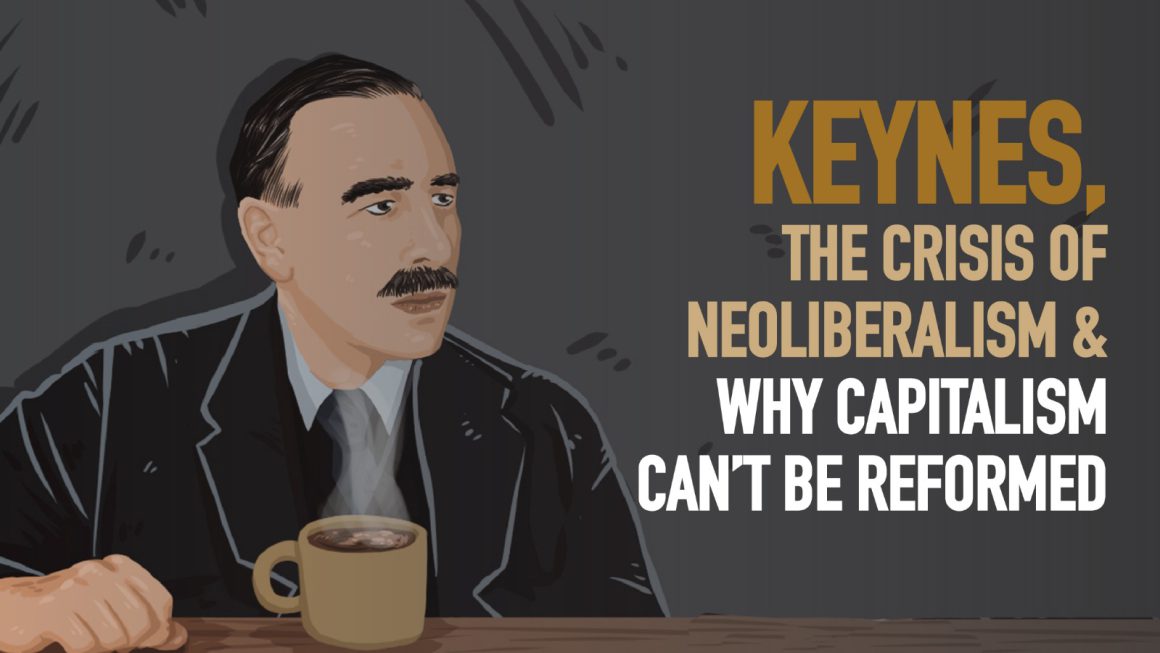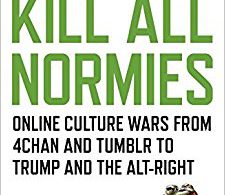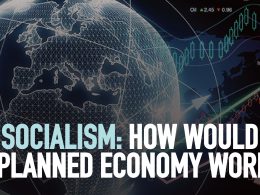Covid-19 has turned the world upside down, making all that was considered impossible now seem possible. In the context of a new crisis for capitalism and the undermining of the neoliberal order globally, the ideas of the liberal economist John Maynard Keynes will increasingly gain traction in terms of the policies of capitalist governments, writes Cillian Gillespie.
The Covid-19 crisis is wreaking devastating havoc on the lives of working-class and poor people throughout the planet. Not only in the form of the virus itself but also in the economic crisis accompanying it, considered by many to be the worst since the Great Depression of the 1930s. The International Labour Organisation (ILO) estimates that 50% of the world’s workers will see their living standards decimated as a consequence of this.(1)
This sharp economic downturn comes just over a decade after the Great Recession of 2008. The recovery that followed was weak and massively lopsided; deepening inequality by intensifying existing neo-liberal trends of growing wealth disparity, increasing workplace precarity, stagnating wages, unaffordable housing and eroding public services.
In the context of the coronavirus crisis, however, capitalist states have been forced to take measures that break with the neo-liberal orthodoxy that they had been wedded to for several decades. This is perhaps exemplified in the decisions of the current Fine Gael caretaker government to — albeit temporarily — create a one-tier health system, with hospitals being brought into the public system; ban evictions; freeze rents; and increase public expenditure through, for example, the €350 ‘Covid-19 Unemployment Payment’. Throughout the world governments have quickly implemented stimulus measures on a scale greater than the period 2008-2009. For example, such a programme implemented by Trump recently accounts for 10% of the GDP of the US. In 2009 this figure, implemented over the course of months, was 5%.
The implementation of these policies is in effect a recognition of the limitations and indeed failures of the private market, and the necessity for state intervention and public investment to deal with a public health emergency of this scale. Of course, the same applies to the pre-existing emergencies in housing, mental health, climate change etc., which should also be recognised. The two-tier health service in the South was evidently incapable of coping with a potential spike in those needing to access Intensive Care Units.
Neoliberalism exposed
The representatives of capitalism globally are clearly wary that a consequence of the current crisis will be an exposing of their system, provoking further political and social instability. Even prior to the outbreak of the Covid-19 crisis it was clear that the social basis of neo-liberalism was being drastically undermined. This was witnessed last year in the revolutionary upheavals in countries as diverse as Sudan, Lebanon, China (Hong Kong) and Chile.
Closer to home, the election in the South in early February, which saw the vote of the two main parties of Irish capitalism fall to a historic low of 45%, is indicative of the process. Notwithstanding the existence of a growing economy, the housing and health crises fuelled by policies benefiting private profit created an enormous groundswell of anger. It shows the base of support for those parties of the so-called “political centre” (i.e. the traditional capitalist establishment) has been corroded by a decade of crises and inequality.
Given this vista of turmoil for global capitalism, the hegemony of neoliberalism, both ideologically and in terms of the policies of capitalist governments, is being further brought into question. State intervention, including increased public expenditure and even nationalisation (of failing companies), will increasingly come on the order. It’s likely then that the ideas, or variants of the ideas, of the economist John Maynard Keynes will be reembraced as far as the thinking of the strategists of capitalism are concerned.
This is also true of prominent figures and organisations articulating left-reformist approaches within the left and workers’ movement, such as Bernie Sanders and Alexandria Ocasia Cortez (AOC) in the US, as well as the more right-wing and class collaborationist expression of reformism, such as that found in the leadership of the Irish Congress of Trade Unions (ICTU). In fact, Keynes biographer Lord Robert Skidelsky has been invited to ICTU conferences to discuss alternatives to neoliberalism. (3) His ideas have acted as a political ballast for the idea that capitalism can ultimately overcome the crises that are inherent within it, and can be made more rational, and in turn more humane.
Who is Keynes? What is Keynesianism?
Keynes was not a socialist, nor of the workers’ movement, notwithstanding the fact that he is today a figure championed by many on the reformist left. He was a liberal economist born into the privilege of Britain’s ruling class. His famous dictum that, “The class war will find me on the side of the educated bourgeoisie”, illustrates whose class interests he was fundamentally concerned with. This was the starting point for his economic prognosis and solutions, something that the champions of his ideas in the workers movement who argued that capitalism can in some way be reformed have ignored and brushed over. Exemplifying this approach, Brendan Ogle, prominent official with Unite trade union, wrote in his book From Bended Knee to New Republic:
In essence, Keynes held that full employment and price stability could best be delivered not through complete market liberalism, but through Government intervention with policies that held the nation’s output as the key dynamic to be considered rather an individual’s. Keynes, you see, believed in “society”. (4)
Keynes and his ideas came to prominence and gained traction initially in the interwar period where economic crises developed in the aftermath of the chaos of the World War. The Russian Revolution and the further revolutionary upheavals that emerged from these events posed a real existential threat to capitalism. This was particularly true with the onset of the Great Depression from 1929 with the emergence of mass unemployment and the devastating impact this had on the living standards of working-class people globally.
Mainstream capitalist economists at the beginning of the Great Depression doggedly stuck to the concept of the “hidden hand of the market”; insisting that supply and demand, competition and free trade — without state intervention — would naturally overcome the economic slump. The dynamic of a system based on private enterprise, they argued, was both self-correcting and self-regulating and would soon lead to a period of growth and an upswing for the system.
However, as the scale of the crisis became more apparent, Keynes and the capitalist governments he influenced, drew the conclusion that the ‘laissez faire’ attitude of the neoclassical school of bourgeois economists was simply not fit for purpose. Not only was capitalism faced with the challenge of working-class revolt and revolution in many of its heartlands – there was also the existence of the Soviet Union, which was making significant economic strides in the 1930s, while capitalist economies faltered. The Soviet economy, notwithstanding the brutal, dictatorial rule of the bureaucratic caste that wielded political power headed and personified by Stalin, was based on state ownership and planning of its key resources, and demonstrated that an alternative to capitalism was viable. In a letter to newly elected US president, Franklin D. Roosevelt, Keynes starkly laid out the choice that their system was confronted with and why a change of course for was necessary:
“You have made yourself the Trustee for those in every country who seek to mend the evils of our condition by reasoned experiment within the framework of the existing social system. If you fail, rational change will be gravely prejudiced throughout the world, leaving orthodoxy and revolution to fight it out.”
The Great Depression & the ‘New Deal’
Such a course for Keynes meant greater government intervention into the economy to regulate the blind forces of the market. In his works, such as his 1936 magnum opus, The General Theory of Interest, Employment and Money, Keynes emphasised the need for aggressive and inflationary state intervention and expenditure in, for example, programmes of public works, e.g. the building of airports, train stations and roads, to create employment. In doing so, they would stimulate “effective demand” on the part of working-class people, and in turn create a market for the goods and services produced by private capitalist companies.
Through the provision of infrastructural programmes that stimulate the economy and create direct employment, it is argued, the demand for goods and services is increased, incentivizing capitalists to invest their hoarded profits in production and enterprises and lay the basis for full employment. The advocates of an unregulated, free market capitalism believed in the concept of “supply side economics”, that is to say, that supply of goods via capitalist investment would invariably meet a demand (mainly from workers) in the market, an argument put forward by the 18th century French economist Jean Baptiste Say. Therefore, it was simply a question of encouraging private investment in the economy via measures such as low corporation tax and de-regulation.
The first notable capitalist government to experiment with Keynes’ ideas in the period of the1930s was the Presidency of FDR through his famous “New Deal”. Roosevelt came to power against the backdrop of mass unemployment and resurgent trade union battles — with socialists, including the rank and file of the Communist Party (which soon grew to 100,000 members) and the small forces of US Trotskyism to the fore. Against this backdrop, his Presidency introduced a series of programmes to create employment and reforms such as the Social Security Act in 1936. While these measures helped to partially raise living standards and temporarily create jobs, it was not the decisive factor in lifting the US out of the slump. It must also be noted that US capitalism had greater economic reserves, as the world’s emerging capitalist power, to implement the reforms implemented in the New Deal, unlike those of the declining capitalist powers of Europe.
Between 1934 and 1937, some five to seven million jobs in the US were created. However, this period of relative economic recovery was soon followed by a downturn in 1937-1939 and unemployment by the end of the decade stood at 10 million. The looming war in Europe and Asia, that US capitalism was eventually dragged into in December 1941, forced the creation of a new war economy, which did result in full employment and a new boom. This, not the measures of the New Deal, would prove critical to US capitalism overcoming the Great Depression that produced a decade of mass working-class struggle and general turbulence.
No solution to capitalist contradictions and crises
A key flaw in Keynes’ analysis was that it failed to recognise the fundamental contradiction of capitalist production. Linked with this was his failure to answer the question of where the resources would come from to fund the stimulus measures that he advocated. Would it come from the profits of big business and the super-rich, or from new taxes (direct or indirect) on working-class people? The capitalist class do not invest for the purposes of meeting “demand”, or social need in general. They are driven by the pursuit of accumulating short term profit. Raising wages and taxes on these profits will adversely affect profit margins and make capitalist firms less competitive relative to their rivals. They will always, in practice, resist policies that impact their bottom line.
Capitalists can provide finance in the form of loans to fund stimulus measures, but again banks and bondholders on the financial markets are there to make money, not to provide credit for credit’s sake, and will ensure that such loans are paid at exorbitant rates — adding to public debt, which has to be sustained or paid back with interest eventually. Hence, if the capitalist class are unwilling to pay for these measures, invariably it is the workers who will be forced to do so, thus once again undermining the market for goods and creating a new deflationary spiral.
It is also a mistake to assume that capitalist investment, as a result of higher demand for their goods, will lead to high rates of employment. The logic of capitalist competition means that the bosses will invest at a much greater pace in labour saving technology (as we see with automation in many fields today) than in the size of their respective workforces. New value in the course of production, however, from which all profits ultimately derive, is produced by the living labour of those very workers: not from the “dead labour” of machines or other forms of what Marx called “constant capital” — raw materials, tools etc. Over time this process of replacing living labour with dead labour leads to a fall in the rate of profit, which in order to be restored requires renewed attacks on the conditions of workers — cutting wages or extending the working day.
Keynes, and those who have championed his ideas within the capitalist establishment, as well as the left and workers’ movement, sought to deny that there was a fundamental conflict of interest between the working class and the capitalist class. By their reasoning, if the state simply created demand amongst workers for goods and services the capitalist class would invest their resources into the system, in the interest of both classes.
In fact, the inherent exploitation on which capitalism is built means that it is fundamentally incapable of sustaining aggregate demand and overcoming the problem of “underconsumption”. Workers never receive in their wage packets the full sum of the value they create. The surplus value goes to the bosses, meaning the workers, who also make up a large share of the consumers, can’t buy back all the things they produce, resulting in periodic crises of overproduction. Such crises are not automatic as indeed many goods produced by workers are for consumption of the capitalists or the super-rich, themselves such as luxury goods e.g. yachts and capital goods such as machinery for production and manufacturing. These commodities differ from those that are consumed on an ongoing basis by workers such as foodstuffs, clothes, cars etc.
There are other ways of getting around this contradiction, temporarily, to avoid (or delay) a descent into immediate crisis for the system. In the US, for example, where real wages have stagnated since the 1970s and where consumer spending accounts for 70% of economic growth, workers’ spending has been fueled by the extension of cheap credit — leading to record levels of private debt. But at a certain point these credit bubbles must burst, and the crisis happens with a vengeance.
The exception of the post-war boom
The period in which Keynesian ideas reigned supreme in terms of government policy, coincided with capitalism’s so-called “Golden age”. This being the enormous economic expansion that followed the Second World War. The vast destruction of cities, infrastructure and industry during the war and the rebuilding of the capitalist economies of Western Europe resulted in the restoration of the profit rates of the capitalist class. This boom, combined with the power of the organised labour movement (and in the shadow of the expanding Stalinist world whose power and prestige had been massively boosted), resulted in the system making significant concessions to the working class to cut across the potential for social upheaval.
US imperialism, which emerged from the war unscathed, now reigned supreme in world capitalism and the institutions it played a crucial role in establishing in 1944 at Bretton Woods conference (which Keynes himself attended), namely the World Bank and International Monetary Fund, played a key role in promoting state interventionist and Keynesian policies. This resulted in significant increases in the living standards of workers, particularly in the advanced capitalist countries, in the form of rising wages and state expenditure being expanded to fund free health, education and public housing in many states. Alongside this, there was a greater share of public ownership in the economy, what’s often been termed a ‘mixed economy’.
The degree to which Keynesian ideas became the orthodoxy of global capitalism was perhaps best summed up by US President Richard Nixon in his famous declaration in 1971; “we are all Keynesians now”. Under the pressure of a militant labour movement in the US, and against the backdrop of the Vietnam war and an explosion in struggle for black, women’s and LGBT liberation, his regime implemented reforms that went totally against his political instincts. As well as being a Cold War hawk, he had built his career on attacking “big government” spending in the New Deal. His policies included the introduction of federal controls on the prices of oil and gas, health and safety legislation in the workplace and the establishment of the Environmental Protection Agency (EPA).
Followers of Keynes (of different hues) look back on the post-war period to prove the validity of his ideas, yet they fail to explain why this period of unprecedented growth gave way to capitalist crisis in the mid 1970s. By the late 1960s growing capitalist competition between the US on the one hand and the rebuilt capitalist economies of Germany and Japan on the other, and the existence of a powerful workers’ movement that played a role in defending workers’ wages and conditions, resulted in falling profit rates and a profit squeeze for the system. Capitalist investment dried up resulting in a period of “stagflation” — combining inflation, which saw wages undermined by skyrocketing prices, and stagnating growth — throughout much of the 1970s and early 1980s.
The profitability and profit rates of the system could only be restored by attacking the share of wealth in society going to labour, in favour of capital. This meant slashing wages and the public investment that funded the “social wage” of the working class, necessitating a full-frontal attack on the power of the organised working class.
The rise and decline of neoliberalism
Just as Keynes’ ideas gained currency amongst the capitalist establishment in response to the crisis of the 1930s, the crisis of the 1970s — marking the end of the post-war boom — persuaded the capitalists to discard Keynesianism in favour of policies known as “monetarism” or “neoliberalism”. Leading advocates of these ideas included Milton Friedman, and his followers in the Chicago School, and the initial laboratory to test their ideas was Chile, after the CIA-backed overthrow of the leftist government of Salvador Allende, and the establishment of the dictatorship under Augusto Pinochet. The most prominent figureheads and crusaders for neoliberalism in the advanced capitalist countries were the regimes of Margaret Thatcher and Ronald Reagan. Central to their project was waging war on the organised working class, most notably in the Air Traffic Controllers Strike in the US (1981) and the Miners Strike in Britain (1984-1985).
The policies of neoliberalism involved privatising public services, cutting social expenditure, de-regulating financial markets, abolishing capital controls and attacking wages and conditions in the workplace. In essence it meant that hard won constraints on the ability of bosses to mercilessly exploit the working class were shelved. In place of Keynesian deficit spending, a tight reign was to be kept on the budgets of capitalist states (although in the case of the US this has never been adhered to). The European Union, which has been a key driver of neoliberalism has ensured that all EU states have a regime of austerity written into law, by introducing strict rules regarding budget deficits and national debt, preventing them from exceeding 3% and 60% of GDP respectively. These policies were harshly enforced in the context of the Eurozone crisis of the last decade, most destructively in Greece.
A factor that strengthened neoliberal ideology was the collapse of the Stalinist regimes in the Soviet Union and Eastern Europe in the period 1989-1991 as a result of the criminal mismanagement of the unelected and unaccountable bureaucracies that ruled these societies. State ownership and planning of the economy was presented as being inherently inefficient and would inevitably lead to a reduction in living standards. This was not only used to undermine the idea of socialism generally, but was also used to push privatisation of public services and a further deregulation of financial markets. This line of argument was embraced by the leaderships of the mass organisations of the working class. Iin Britain “New Labour” under the leadership of Tony Blair ditched “clause four” of the party’s constitution that committed the party to nationalisation of the key sectors of the economy.
The implementation of neoliberal policies in capitalist countries has obviously not been uniform and the state still plays a crucial role in capitalist development, contrary to the mantra of “the hidden hand of the market”. Even under the Presidency of Ronald Reagan, the US witnessed a form of “militarised Keynesianism” with state expenditure on armaments growing massively.
In the 1990s and 2000s, after the collapse of its property bubble and the ensuing recession, successive governments in Japan, then the second largest economy in the world, implemented a series of large stimulus programmes involving massive investment in public infrastructure. Stimulus measures were implemented in Europe and the US following the 2008-2009 crash, and states, via their central banks, have played a critical role in keeping the capitalist economy afloat through Quantitative Easing (QE) i.e. printing money and cutting interest rates to promote capitalist investment. None of these policies, in Japan or those implemented in the US or Europe, have helped overcome the structural weaknesses of capitalism today.
Reformist half-measures won’t do
Fear of the working class in this epoch of economic, social and political instability means that Keynesian measures in the form of increased state intervention in the economy will see a return. The coronavirus crisis has already accelerated this trend. Such policies, however, do not constitute socialism, as argued by Bernie Sanders. Rather they are reforms implemented within the framework of the private ownership of industry and finance and the rule of private profit. Nevertheless, their implementation will puncture Thatcher’s mantra that “there is no alternative” to the existing economic order.
Keynes’ ideas will no doubt continue to be utilised by reformist trends that will emerge in new left and working-class movements. They will feel emboldened to do so given how much neoliberal capitalism has been ideologically undermined, even if the ruling class still pursues these policies at the behest of big business and the bankers. However, their programmes will come up against the reality that there is a real conflict of interest at the heart of this system, which means that the needs of the capitalist class and working-class majority cannot co-exist peacefully, no matter how “mixed” the economy becomes.
Revolutionary socialists will of course fight for reforms such as state investment to create jobs, increasing wages for workers etc. advocated by reformists and Keynesians alike, but will put forward the need for broader radical change. Capitalism is based on crises, which are becoming increasingly severe in the 21st century, and the accumulation of capital and wealth by the billionaire class can only happen at the expense of our living standards, our health and our environment.
There is a real alternative, however: one that doesn’t tinker with this or that aspect of the rapacious market system that’s driven by short-term profit making, but instead replaces the drive to make profit with the drive to provide for people’s needs; and replaces market anarchy with rational, democratic planning of the economy; that replaces the rule of a tiny elite with the rule of the immense majority. This can only be achieved by, in the words of Karl Marx, “expropriating the expropriators”. That is, to seize the wealth and resources that working people have created, and bring them into public ownership under their management and control. Doing so will lay the basis for an international socialist society where our planet is safeguarded and human beings will develop to their full capabilities and talents.
- “Half of world’s workers ‘at immediate risk of losing livelihood due to coronavirus”, Guardian, 29 April 2020,
- https://www.ictu.ie/press/diary/2010/10/12/building-an-alternative-vision-skidelsky-lecture/
- Brendan Ogle, From Bended Knee to a New Republic: How the Fight for Water is Changing Ireland, Liffey Press (2016), p.32
- “Open Letter to President Roosevelt”, New York Times, 31 December 1933












